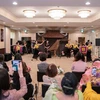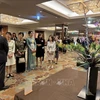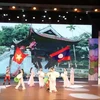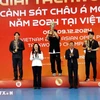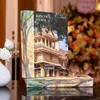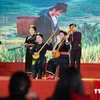The striking performance of ancient citadel dances at Hanoi 's Ly Thai To Garden last night was a stark reminder of the need to research and preserve the nation's cultural heritage.
he dances from the Thang Long (former name of Hanoi ) era were presented at the garden, near the post office on Hoan Kiem Lake , to celebrate the city's 1,000th anniversary.
Performed by members of the Hanoi Dancers' Association, they have stood the test of time thanks to a project led by People's Artist Le Ngoc Canh in the 1980s to collect 54 ancient dances and recorded and revive them.
Canh said the collection included spiritual Buddhist dances like Luc Cung Dance, Giai Oan Thich Ket Dance.
"However, I regret that many ancient dances have died out," he said.
For instance, he remembered watching a Light Dance at Dong Nhan village in today's Hai Ba Trung district in 1954, but when he conducted his study, nobody could remember the dance.
The same fate had befallen the Cup Dance of Moc village, in today's Thanh Xuan district.
Canh said the nation risked losing other historic cultural activities with the passage of time unless moves were made to record them.
For example, former Ha Tay province still contained ancient cultural traces which had not been studied properly and documented.
Nevertheless, the dance research that had been carried out in the past 25 years and been very fruitful and had recorded genres in Hanoi including folk, worship, religious and royal dances and had underpinned revival performances, such as the one last night.
Canh said many of the royal dances in Thang Long had mingled with those practised in the Hue citadel under the Nguyen Dynasty while many of the others were associated with festivals.
"The old dances will live forever, together with the village culture," Canh said.
Bai Bong dance, for example, which originated in Phu Nhieu village, Phu Xuyen district, was one among the most typical dances from the project archives to be performed at the concert.
There are now four teams from four generations practising Bai Bong Dance in Phu Nhieu Commune, he said.
Dancer Nguyen Thi Ga, who just died a week ago aged 102, had been performing Bai Bong since she was 10 and had helped keep the style going until she got too old.
Canh said that following on from the archive project, a documentary to record 30 of the dances was being made and modern choreographers were hoping to use the old dances to compose modern versions.
"The central matter is budget," Canh said. "Old dancers have joined the documentary project for the past five years through their own enthusiasm and got no pay at all."
The budget for organising old-style dance festivals in the traditional Lunar New Year periods between 2008-10 had been limited. Each dancer had received only 10,000 VND (0.5 USD) for their performance plus a transport subsidy./.
he dances from the Thang Long (former name of Hanoi ) era were presented at the garden, near the post office on Hoan Kiem Lake , to celebrate the city's 1,000th anniversary.
Performed by members of the Hanoi Dancers' Association, they have stood the test of time thanks to a project led by People's Artist Le Ngoc Canh in the 1980s to collect 54 ancient dances and recorded and revive them.
Canh said the collection included spiritual Buddhist dances like Luc Cung Dance, Giai Oan Thich Ket Dance.
"However, I regret that many ancient dances have died out," he said.
For instance, he remembered watching a Light Dance at Dong Nhan village in today's Hai Ba Trung district in 1954, but when he conducted his study, nobody could remember the dance.
The same fate had befallen the Cup Dance of Moc village, in today's Thanh Xuan district.
Canh said the nation risked losing other historic cultural activities with the passage of time unless moves were made to record them.
For example, former Ha Tay province still contained ancient cultural traces which had not been studied properly and documented.
Nevertheless, the dance research that had been carried out in the past 25 years and been very fruitful and had recorded genres in Hanoi including folk, worship, religious and royal dances and had underpinned revival performances, such as the one last night.
Canh said many of the royal dances in Thang Long had mingled with those practised in the Hue citadel under the Nguyen Dynasty while many of the others were associated with festivals.
"The old dances will live forever, together with the village culture," Canh said.
Bai Bong dance, for example, which originated in Phu Nhieu village, Phu Xuyen district, was one among the most typical dances from the project archives to be performed at the concert.
There are now four teams from four generations practising Bai Bong Dance in Phu Nhieu Commune, he said.
Dancer Nguyen Thi Ga, who just died a week ago aged 102, had been performing Bai Bong since she was 10 and had helped keep the style going until she got too old.
Canh said that following on from the archive project, a documentary to record 30 of the dances was being made and modern choreographers were hoping to use the old dances to compose modern versions.
"The central matter is budget," Canh said. "Old dancers have joined the documentary project for the past five years through their own enthusiasm and got no pay at all."
The budget for organising old-style dance festivals in the traditional Lunar New Year periods between 2008-10 had been limited. Each dancer had received only 10,000 VND (0.5 USD) for their performance plus a transport subsidy./.

